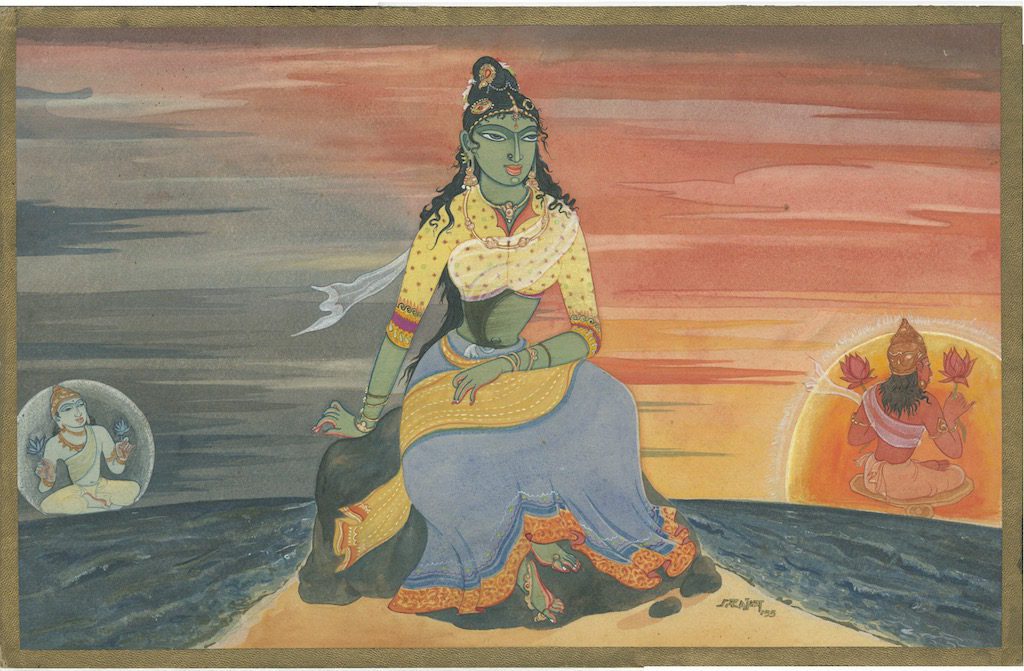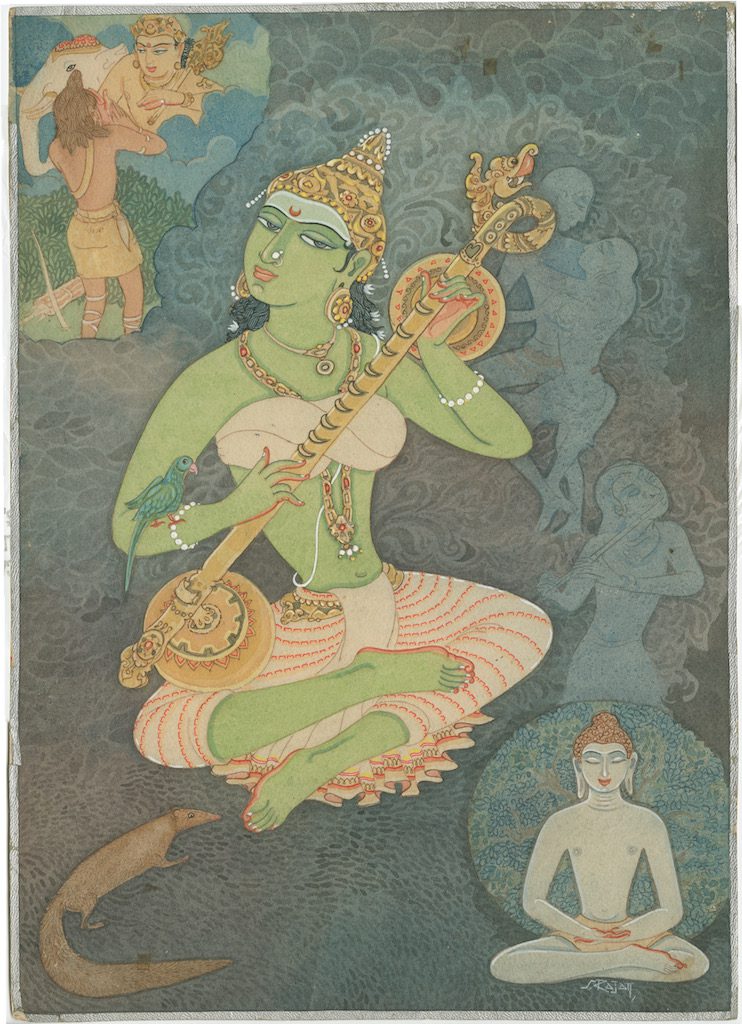
Mahadevi, the Great Goddess, has many names and forms in Jyotish, the Vedic astrological science of light. These range from her overall cosmic influence to specific associations with planets, signs, Nakshatras and phases of the Moon. In Hindu thought, the Goddess is the Mother of the Universe from whom the origin, sustenance and dissolution of everything arises. She governs over the whole of time, as past, present and future, and all of space.
As the Supreme Mother, the Goddess cannot be limited to a single planet, sign or astrological indication. Her influences occurs on many levels and in many dimensions, coloring all the forces of the universe, which are manifestations of her Supreme Shakti. She possesses all the forms of the feminine nature, as well as all the forces and creativity of life and light. She is also formless, extending to the original matrix of time and space. We will introduce her main astrological manifestations.
THE GODDESS AND THE MOON AND THE SUN
The Moon is well known throughout the ancient world and in traditional cultures as the main manifestation of the Goddess. This is true in Vedic astrology as well. The Moon is the face and the smile of the Universal Mother and grants her grace, peace, inspiration, insight and bliss. When we are gazing at the Moon, it is Her presence that we are contacting and her subtle energies that we can draw in. Vedic astrology honors different aspects of the Goddess relative to her location in the zodiac and the time of the lunar month. So many poets and rishis have honored the Divine Mother and the Moon, notably in her form as Uma.
The Moon is ruled over by the force of the Cosmic Waters (Apas), which are a form of the Goddess. The Goddess as Uma Parvati, the consort of Shiva, is the presiding deity (pratyadhi-devata) of the Moon. Parvati also means she who has parts, indicating the many phases and changes of the Moon. Parvati is the Goddess of nature, the wild and yogic ascetics. She is the supreme Yogini and Yoga Shakti, leading us to the transcendent Shiva.
However, in the ancient Rigveda hymn on the Marriage of the Sun and the Moon (RV X.85), the Goddess is identified with the Sun, and the Moon is her male suitor moving around her and wooing her. As the Sun Goddess, she is called Surya Savitri, with Savitri as the knowledge power of the Sun (Surya). The Goddess is related to the worship of the Sun at sunrise (Gayatri), noon (Savitri), and sunset (Sarasvati), which are three Sandhyas or transitional times, with Sandhya also a form of the Goddess. As Ushas, she is also the Goddess of Dawn in the Vedas. As Aditi, she is the Universal Mother Goddess that gives birth to all the Sun Gods (Adityas). Other Hindu Goddesses that are associated with the Moon can also be associated with the Sun, like Ma Durga, who rides the solar lion.
THE GODDESS AND THE PLANETS
The Goddess is well known to relate to the Moon and Venus among the planets, which are generally regarded as feminine. The Moon is more the Great Mother, caring for all, while Venus is more the wife or beloved, her beautiful or alluring form, notably Lakshmi as the Goddess of prosperity, fertility and abundance. In Vedic astrology, the Goddess has connections with Mercury, Saturn and Rahu, which are often regarded as neutral or dual in gender. Mercury as her youthful form as Sarasvati grants knowledge, art, music, dance and culture. Saturn as her grandmother form gives wisdom, discipline and detachment. Rahu as her mysterious form shows mystery, illusion and transcendence.
In the Tantric Yoga Devotional system of the Ten Wisdom Goddesses (Dasha Mahavidya) we find the following order of Goddesses for the planets.
Mahakali – as the Great force of time and eternity (Kala) behind the Sun and Moon and all the planets.
SUN with Bhuvaneshvari, the Queen of the Universe, governing the whole of space, sharing the solar mantra HREEM.
MOON with Tripura Sundari, the Goddess of Beauty and Bliss, Soma and the nectar of immortality.
MARS with Tripura Bhairavi, the Goddess of Fire, Purification and Transformation, the Warrior Goddess.
MERCURY with Matangi, the Goddess Speech and Art and the creative forces of nature, a form of Sarasvati.
JUPITER with Tara, the High Priestess and Voice of the Guru, connected with the highest wisdom and power of judgement.
VENUS with Kamala, the Lotus Goddess, a form of Lakshmi, granting all happiness, grace and fertility.
SATURN with Dhumavati or Jyeshta, the Grandmother form of Kali, with her wisdom, power and mystery.
RAHU, the Serpent’s Head, with Bagalamukhi, who has the power to stop and to paralyze, and makes our enemies speechless.
KETU, the Serpent’s Tail, with Chinnamasta, and her cut off head, who carries the deepest mystic secrets of going beyond the mind.
There are many such correlations. Warrior Goddesses like Chandi in the Deva Mahatmya and the fierce red form of Kali are associated with the planet Mars. Imperious Ma Durga with her weapons riding a lion relates to the Sun. Different Goddesses can be worshipped for countering negative planetary influences. For example, Ma Durga can be approached to counter the negative effects of Rahu.
THE GODDESS AND THE SIGNS OF THE ZODIAC
The Goddess is naturally associated with Taurus, ruled by Venus and where the Moon is exalted; Cancer, ruled by the Moon; and Libra, ruled by Venus, as the Venus and the Moon are feminine planets. Yet she is also associated with Virgo ruled by Mercury, depicted as a young girl (Kanya), with the exuberance of youth and creativity, arts and crafts. Gemini meanwhile is a portrayed as a couple, male and female, in Vedic astrology, not simply twins, so a feminine energy is also there.
In a general sense, zodiacal signs in even numbers are associated with the Goddess. These are Taurus, Cancer, Virgo, Scorpio, Capricorn and Pisces. Of these signs, Pisces, where Venus is exalted, has a notable feminine energy and grants emotional sensitivity, creativity, imagination and caring. Capricorn and its crocodile (Makara) are associated with Ma Ganga, the great river, and with Mother India as a country, particularly North India, while Virgo is associated more with South India.
Relative to the Moon, however, its influence in a sign varies by its phase. The full Moon will energize the signs more with lunar qualities that will the new Moon.
In addition, whatever sign that feminine planets like Venus or the Moon are transiting, while have their feminine qualities emphasized.
THE GODDESS AND THE NAKSHATRAS
In Vedic symbolism, all the Nakshatras are generally regarded as feminine and the Moon as masculine, so all the Nakshatras have feminine names. The Moon in its movement unites with their energies. Nakshatras are ruled by specific deities from the older Vedic pantheon. Each of these Nakshatra deities has a feminine counterpart or Shakti.
In addition, Specific Nakshatras are connected to the Great Goddess. Notably, she relates to the Nakshatras in Scorpio and Sagittarius that mark the Milky Way region by the Galactic center, as well as those opposite in the zodiac in the sign of Taurus. Rohini/Aldeberan/Taurus is regarded as her Lakshmi youthful form, and Jyeshta/Antares/Scorpio is her elder harsh, grandmother form. Yet she has many other Nakshatra connections.
KRITTIKA (26 40 Aries—10 00 Taurus), the Pleiades, seven sisters, wives of the seven Rishis (identified with the stars of the Big Dipper), and associated with Ma Durga or Skanda Mata as the Mother of Agni, the fire God related to the planet Mars.
ROHINI (10 00—23 20 Taurus) marked by the bright red star Aldebaran. Identified with the youthful and Lakshmi form of the Goddess, said to be the favorite of the Moon in Vedic thought, reflecting her beauty and abundance.
PUNARVASU (20 00 Taurus-03 20 Gemini), ruled by Aditi, the cosmic mother Goddess and mother of the Sun Gods (Adityas), related to Bhuvaneshvari, the Queen of the Universe, Mother nature and Mother Earth in Tantric thought.
PUSHYA (03 20—16 40 Cancer), while ruled by Brihaspati and associated with Jupiter and Brahma as the Creaor, it has a feminine reflection in Devi Sarasvati and the lunar creative force.
HASTA (10 00—10 Virgo) while ruled by Savitr as the inspirational form of the Sun God; his consort Savitri is also honored here along with her solar connetions.
ANURADHA (03 20—16 40 Scorpio), connected to the Goddess Radha, consort of Sri Krishna, and the power of devotion. Note that Rohini opposite to Anuradha in the zodiac is also Krishna’s Nakashtra.
JYESHTA (16 40—30 00 Scorpio), marked by the bright red start Antares (alpha Scorpio in astronomy). The elderly and fierce form of the Goddess of Ma Kali called Jyeshta or Dhumavati is worshipped here, with connections to the Kundalini.
MULA (00—13 20 Sagittarius), Marks the galactic center, relates to Ma Kali as time, karma, origin and dissolution. Requires we develop deep discernment to go beyond Maya.
PURVASHADHA (13 20—26 40 Sagittarius), ruled by the Apas, the Water Goddesses, associated with Soma and the Moon in Vedic thought; marks the waters of the Milky Way.
THE GODDESS AND THE PHASES OF THE MOON (TITHIS)
Different Goddesses relate to different phases of the Moon called tithis in Sanskrit. There are fifteen of these phases or lunar days of the waxing and waning Moon. For some examples, Sarasvati relates to the fifth tithi, most important in the spring season that marks Sarasvati Puja, Durga relates to the eighth tithi or half Moon, and Kali relates to the fourteenth tithi of the waning Moon. In addition, each tithi has its own Shakti or feminine force.
Ma Durga relates to the Navaratri or nine-night festival that occurs in the autumn. This is marked by the first nine tithis of the lunar month of Ashwin (when the full Moon occurs in Aries). It begins with the New Moon, with each day marked by a special form of Durga. The tenth day is also dedicated to the Goddess as the Day of Victory (Vijay Dashami). This festival generally occurs in October. The same celebration can be performed in the spring, during the lunar month of Chaitra, when the full Moon is in Libra, generally in April.
Different forms of the Goddess have their birth or manifestations dates during the year (Jayanti). For example, Tripura Sundari Jayanti is the full Moon of the month of Margashira (Taurus/Gemini). As there are numerous forms of the Goddess, there are such Jayantis for an aspect of hers every month, sometimes more than one.
In conclusion, the Vedic view of the Mother of the Universe and Divine Feminine is to honor all of her forms reflected in time and the sky, from the youthful to the elderly, from the beautiful to the fierce, as mother, sister, daughter, wife and beloved, from the mundane to the Transcendent. This includes a wide variety of astrological and astronomical associations. Understanding the Goddess and the World Mother (Jaganmata, Jagadamba) is essential for understand the Vedic view of time and karma.
For Vedic Astrological Consultations, please contact Yogini Shambhavi
JAI MA!







